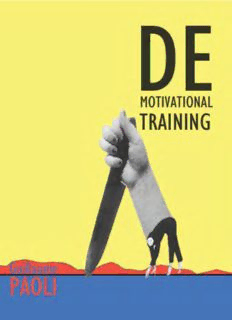
Demotivational Training (Éloge de la Démotivation) PDF
Preview Demotivational Training (Éloge de la Démotivation)
Demotivational Training (Éloge de la Démotivation) Guillaume Paoli translated by Vincent Stone First U.S. edition published by Cruel Hospice 2013 Cruel Hospice is a place where a terminally-ill society gets the nasty treatment it deserves. Anyone trying to resuscitate the near dead is a legitimate target for criticism. Printed by LBC Books http://lbcbooks.com Cover art by Tyler Spangler English translation by Vincent Stone Printed in Berkeley First printing, December 2013 To Renate, for so many motives 1 Why Do Something Rather than Nothing? 16 Compulsory Markets 44 The Company Wants What’s Best for You (Don’t Give It to Them) 67 The Work Drug 90 Metamorphoses of the Fetish 122 Canceling the Project I Why do something rather than nothing? Motivated, motivated, We must be motivated. —Neo-Trotskyist refrain To get a donkey to move forward, nothing is better than the proverbial carrot and stick. At least that’s how the story goes. Having known a few muleskinners myself, I never saw a single one resort to this technique. But whatever the reality may be, it’s a useful metaphor that, like many popular expressions, con- tains and condenses phenomena that are more complex than they seem. From the outset, let’s be clear that it is a question of the carrot and the stick, and not one or the other. There’s not an option, but rather a dialectical relation between the two terms. No carrot without the stick, and vice versa. The stick alone, physical punishment without the carrot, is not enough to encourage continuous and resolute forward progress in the animal. The beaten mule will snort, reluctantly take a few steps, but then stop moving at the first opportunity. To use managerial language: stick beatings are not efficient. In fact, the real effect of the stick is indirect—a permanent threat that can be unleashed at the least sign of diminished effort. It is enough that the don- key realizes that he can be hit, either because he has a painful memory of the experience or because he sees mules around him being hit. It gets him to move, not to reach a goal, but to avoid pain. Specialists describe this phenomenon as a “second- 1 ary negative motivation.” In the ideal situation, it shouldn’t even be necessary to hit the animal, because he has completely inter- nalized the threat. His “interior stick” will seem like an improve- ment on the condition of mules. He will say: “We have nothing to complain about. Previously we were beaten cruelly. Now our life is nicer.” The philosopher Norbert Elias called this tendency the process of the civilization of manners. Nonetheless, all teachers are well aware that every punishment has to be paired with the promise of a reward. Coercion without reward won’t work for long. One isn’t motivated solely by avoiding something, but by that plus attaining gratification. Here’s where the carrot comes in, as somebody dangles it from a stick in front of the animal’s nose. If the psychological forces unleashed by the shaking of the stick are relatively crude, those that are unleashed by the carrot are more complex. First, the animal not only has to see the carrot, but must see only that; so it must be arranged that all other objects disappear from his sight. To achieve this effect trainers have, from time immemo- rial, used blinders. Depending on the sophistication of the donkey, there are various types. For example, some let in light from a specific direction, leaving everything else in shadow so as not to distract the donkey from his goal. Anything that is not the car- rot is either an ideology involving absolute evil or an impracti- cal utopia. Yet as effective as this approach is, it is still coercive. Sometimes a donkey will buck at this authoritarian restriction of his visual field. Keep in mind that the purpose of the carrot is precisely to promote free and voluntary progress. It is easy to 2 see that the best way to focus the will of the animal on a single object is to take away everything else around him so that nothing can distract him from his desire. In the desert there is no need for blinders. So a desert must be made. Once you capture the donkey’s attention, the real work begins. There are two competing sets of interests: the donkey wants to eat the carrot; the donkey trainer wants the donkey to walk. How do we reconcile the two? The animal has to sub- stitute his internal motivation (hunger, desire) for the external one (the carrot, and the path to obtain it). This phase is called identification. Next, once he is hooked, he has to change his be- havior and do what is necessary to reach his goal. There is a greater chance of success if the subject is convinced that he is acting freely and without any outside influence. This is the phase known as adaptation. It spreads easily in mammals with a more social nature than with donkeys, which are more soli- tary—so let’s add a few colleagues. For at this stage a key phe- nomenon comes into play. Each individual colleague believes he has to take a step forward. Why? Because he is convinced that all the others will take a step as well. This is called emulation or free competition. Each believes because he has no choice but to believe, since everyone else believes—“everyone else” being the sum of each person who believes, etc. It’s how a perception becomes an “incontrovertible reality.” The next phase in the process is called well-sublimated failure. For there is clearly no question of whether the goal can be achieved, otherwise he would stop walking and enjoy his 3
Description: